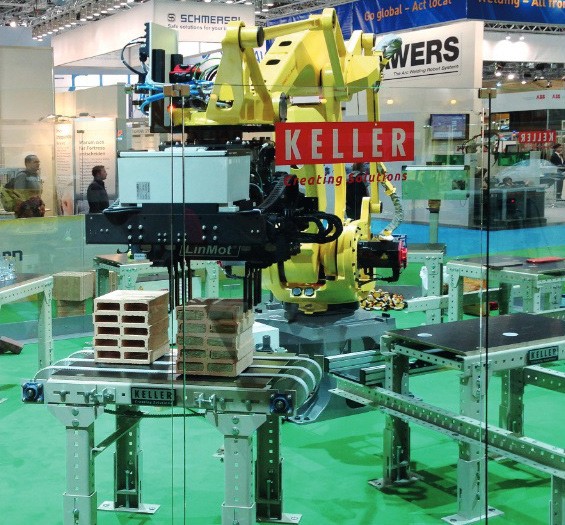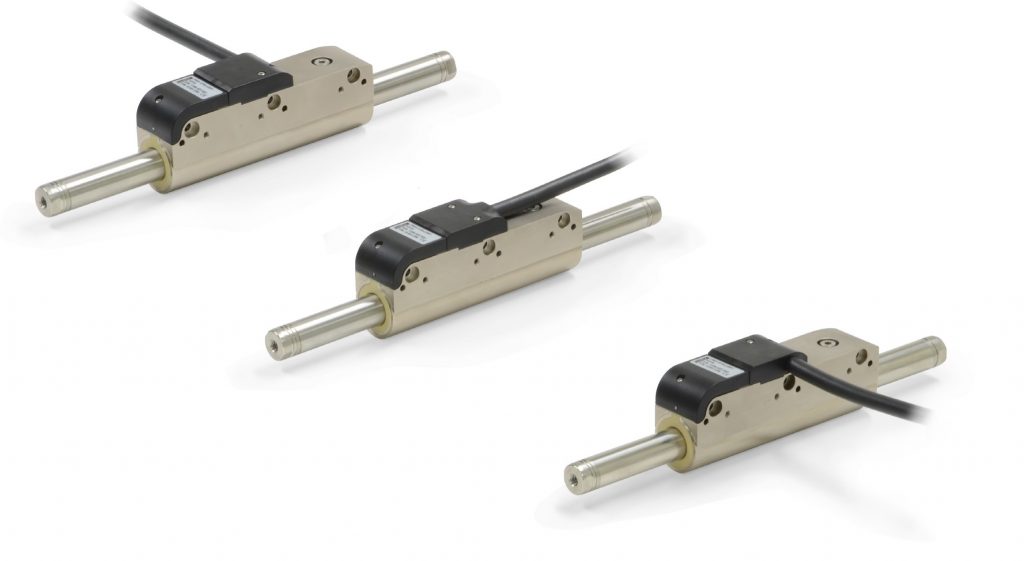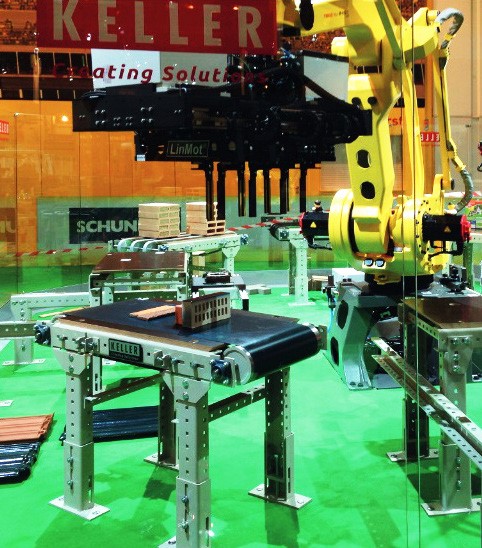By switching from pneumatic cylinders to linear motors, the machine and plant manufacturer Keller HCW has succeeded in developing an innovation in universally applicable robot grippers with high payloads that can even grip, separate and move sensitive products safely and gently. The electric direct drives are not only responsible for the high flexibility of the gripper, but also guarantee repeatability, dynamics, precision and, last but not least, energy efficiency that cannot be achieved with pneumatic drives.

The robot gripper with linear motors developed by Keller HCW can be used universally and can even grip sensitive products safely and gently and group them before setting them down. (Image source: Keller HCW)
Hollow bricks, drinking glasses, cat food packs, beaver tails, tissue packs, tennis balls – the new robot gripper from Keller HCW handles them all safely and with optimum force. The machine and plant manufacturer recently proved this with a demonstration setup that attracted a lot of attention at the Automatica trade fair in Munich. The robot grippers from Keller HCW have been proving themselves for years in brickworks and other companies in the heavy clay industry. They are used there, for example, to grip still unfired bricks (moulded bricks) and place them at a certain distance that guarantees an optimal drying and firing process. The bricks are fed to the gripper on a continuously running conveyor belt in the form of a consolidated bar of about 20 to 30 blanks. The gripper grasps the complete bar, brings the individual bricks to the optimum distance during the robot movement and then sets them down again as a group on special carriers or conveyor belts. “The challenge here is that the strength of the moulded bricks can vary and we can therefore only move with a limited gripping force and approach speed. In addition, there is only a limited time window available in which the bricks have to be gripped by the continuing infeed conveyor belt,” explains Dipl.-Ing. Reinhold Ungruhe, head of automation and electrical engineering at Keller HCW GmbH. Up to now, mainly robot grippers that work with pneumatic drives have been used for separating the bricks, but also for other handling processes in the heavy clay industry.
Adjustment travel previously limited to 10 mm by pneumatics
Due to the limited strokes and the comparatively slow adjustment speed of the pneumatic cylinders, however, the adjustment paths must not exceed 10 mm. This is a disadvantage when different brick shapes and formats run over the same line, as is now increasingly the case. In developed industrial countries, for example, it is now quite common for the few thousand tiles, including the necessary special tiles (such as verge and ridge tiles), required for a house roof to be produced customer-specifically in one batch on one line.
In practice, this has meant so far that the brickworks often purchase several grippers per robot – mostly 6-axis robots – and use them alternately in order to be able to cover all formats and types. However, with acquisition costs of around 50,000 euros per gripper, this ties up a lot of capital in the companies. Alternatively, users have the option of purchasing only one gripper per robot and converting it whenever a change of format or type is required. In order to minimise these time-consuming conversions for the user, Keller has implemented a hybrid gripper in which the pneumatically driven grippers are adjusted with a rotary servo drive in order to be able to group more brick formats and types with one and the same gripper.
Adjusting the pneumatics requires a sure instinct
“However, adjusting the pneumatics is quite difficult in practice,” Reinhold Ungruhe admits. “If only because the pneumatic actuators behave differently depending on the ambient temperature and therefore a precise adjustment of the gripping point and the gripping force is only possible to a limited extent.” Condensation and other impurities in the compressed air do the rest. Moreover, pneumatic cylinders are not maintenance-free: they have to be oiled, for example. Seals also resinify or leak, especially at high operating frequencies of the drive, so that the entire cylinder has to be replaced.
Keller has therefore gone one step further and developed a fully electrically driven demonstration gripper that is free of these disadvantages. Twelve linear motors of type PS01-37Sx120-HP-N from LinMot move the directly attached grippers. They feature a maximum stroke of 120 mm, a maximum force of 122 N and a particularly compact design.

The LinMot linear motor PS01-37Sx120-HP-N from the PS01 series requires little space and is characterised by a large stroke and a high maximum force. (Image source: LinMot)
High dynamics and repeatability with linear motors
“Linear motors can be controlled more precisely and are more dynamic than pneumatic drives. They can also handle much longer travel distances in a short time,” says the Keller specialist for automation and electrical engineering, summarising the advantages. The
pattern in which the bricks are placed can be specified via the system’s user interface and changed at the touch of a button – without any time-consuming conversions or gripper changes. Unlike pneumatic drives, the gripping force can also be controlled directly. This capability and the large stroke in combination with the high dynamics are largely responsible for the fact that the gripper can be used so universally and can handle sensitive products such as jars or cardboard containers just as reliably as robust products. The linear motors in the new gripper are controlled by 12 ProfiNet servo controllers from LinMot’s C1100 series, which were specially designed for applications in which pneumatic cylinders are replaced by linear motors. With a height of 146mm, a width of 26.6mm and a depth of 106mm, the controllers are very compact and lightweight. “This is important with regard to the payload of the gripper, as we wanted to place the controllers directly on the gripper to keep the number of cables routed through the robot to a minimum,” explains Reinhold Ungruhe. However, the disadvantage of the additional weight is usually more than made up for by the elimination of valve terminals, mechanical components and sensors that were previously required, as well as the higher flexibility and repeatability of the electric drives. “For the series, the use of LinMot multi-axis modules or the company’s decentralised motors with integrated drive electronics would also be an option for further weight and space reduction,” adds the automation expert.

The new robot gripper arm from Keller HCW does not require pneumatics thanks to the use of linear motors and therefore saves on operating costs and the environment (Image source: Keller HCW)
Environmentally friendly and economical
In the developed countries, users are focusing on yet another aspect of electric direct drives: the economical use of energy. “More and more manufacturers of heavy clay products are discovering the energy efficiency of their productions as a distinguishing feature and sales-promoting image factor,” reports Reinhold Ungruhe.
Compressed air does not fit into the picture, as it is one of the most inefficient and thus most expensive energy sources. Only about 5% of the energy used is available in the actuator as useful power. Especially in the case of fast cylinders, the high noise level shows that a lot of energy is wasted in the direct sense of the word. The higher purchase costs for an electric actuator quickly pay for themselves. Even with conservative calculations, it pays for itself after a maximum of three years with its efficiency of about 97%. No wonder, then, that more and more companies are endeavouring to dispense completely with compressed air in their production processes. Keller, for example, recently realised a plant for plugging hollow blocks with rock wool completely without pneumatics. “The great interest that the gripper aroused at the Automatica in Munich confirms our assessment that many industries beyond the heavy clay industry are also following this trend and are looking for a flexible and reliable gripping and separation solution based on linear motors,” says Reinhold Ungruhe, looking optimistically to the near future.
You are currently viewing a placeholder content from Yumpu. To access the actual content, click the button below. Please note that doing so will share data with third-party providers.
More Information